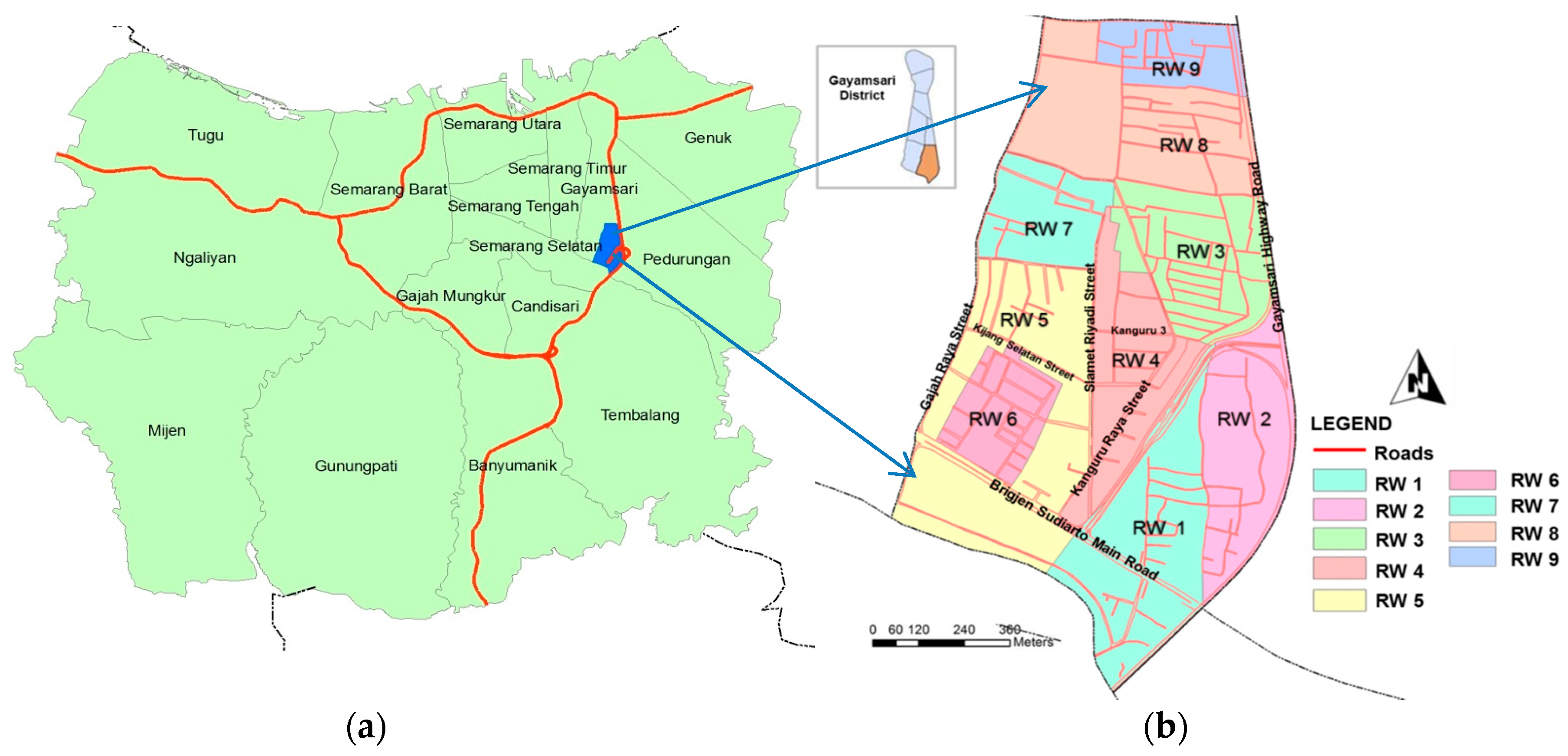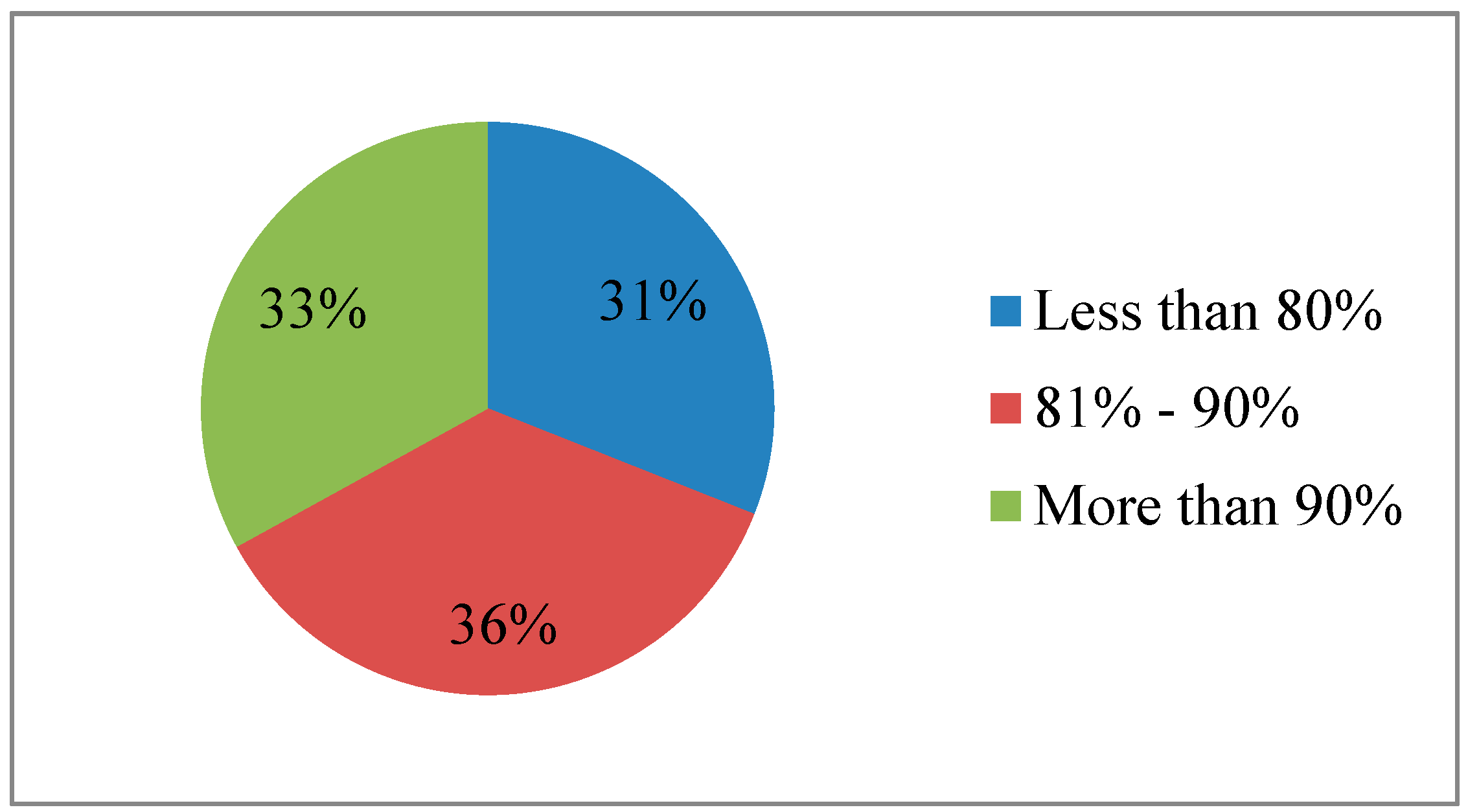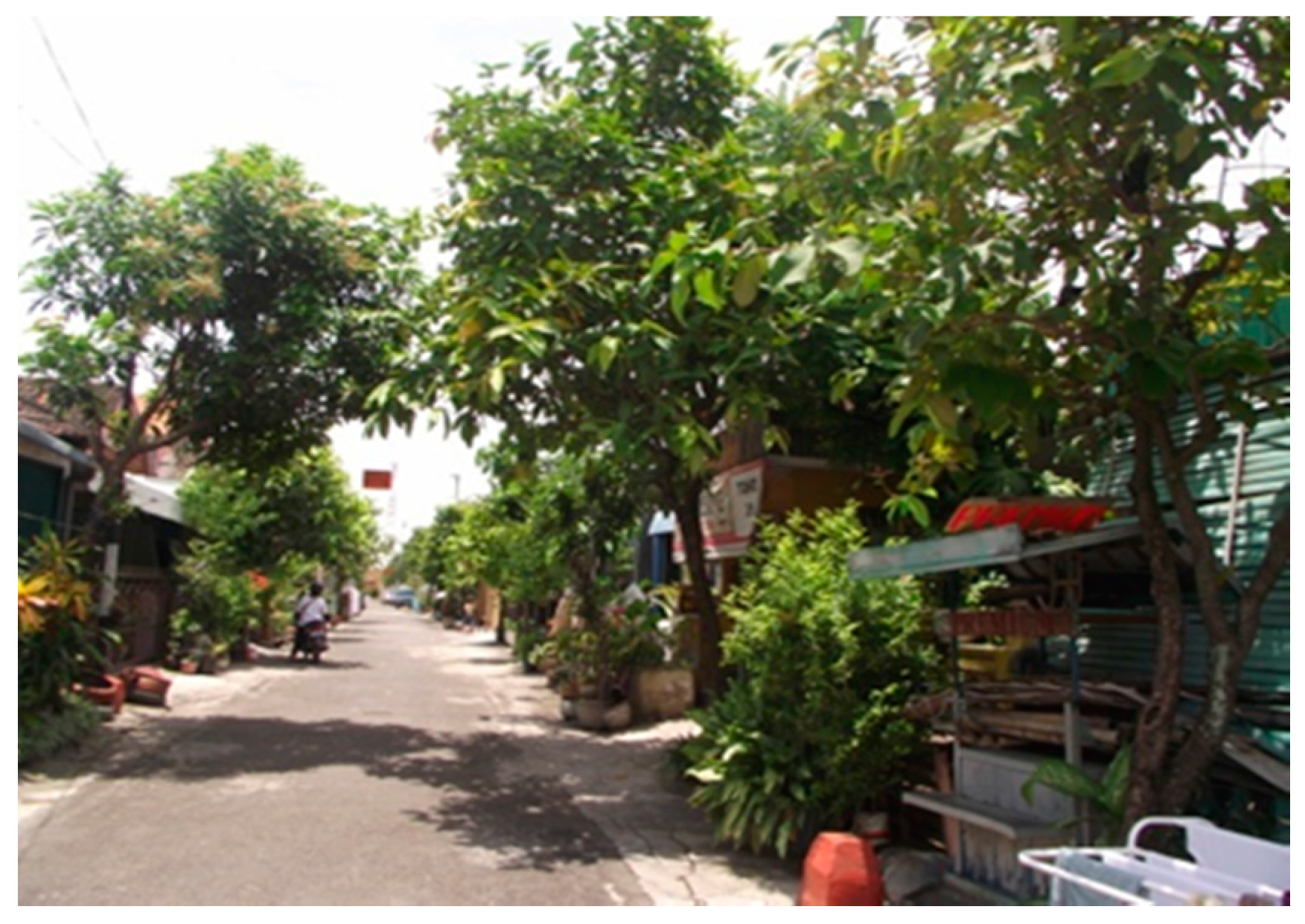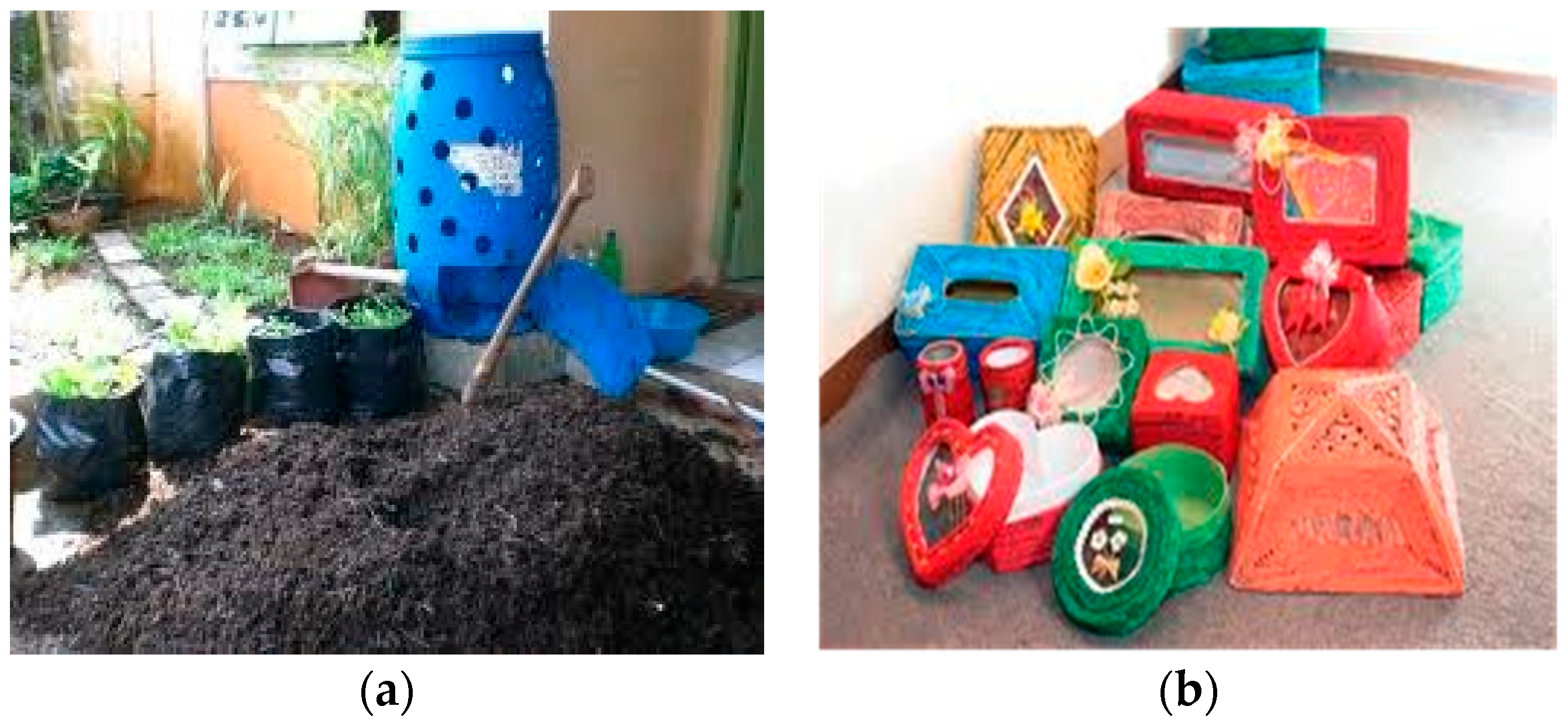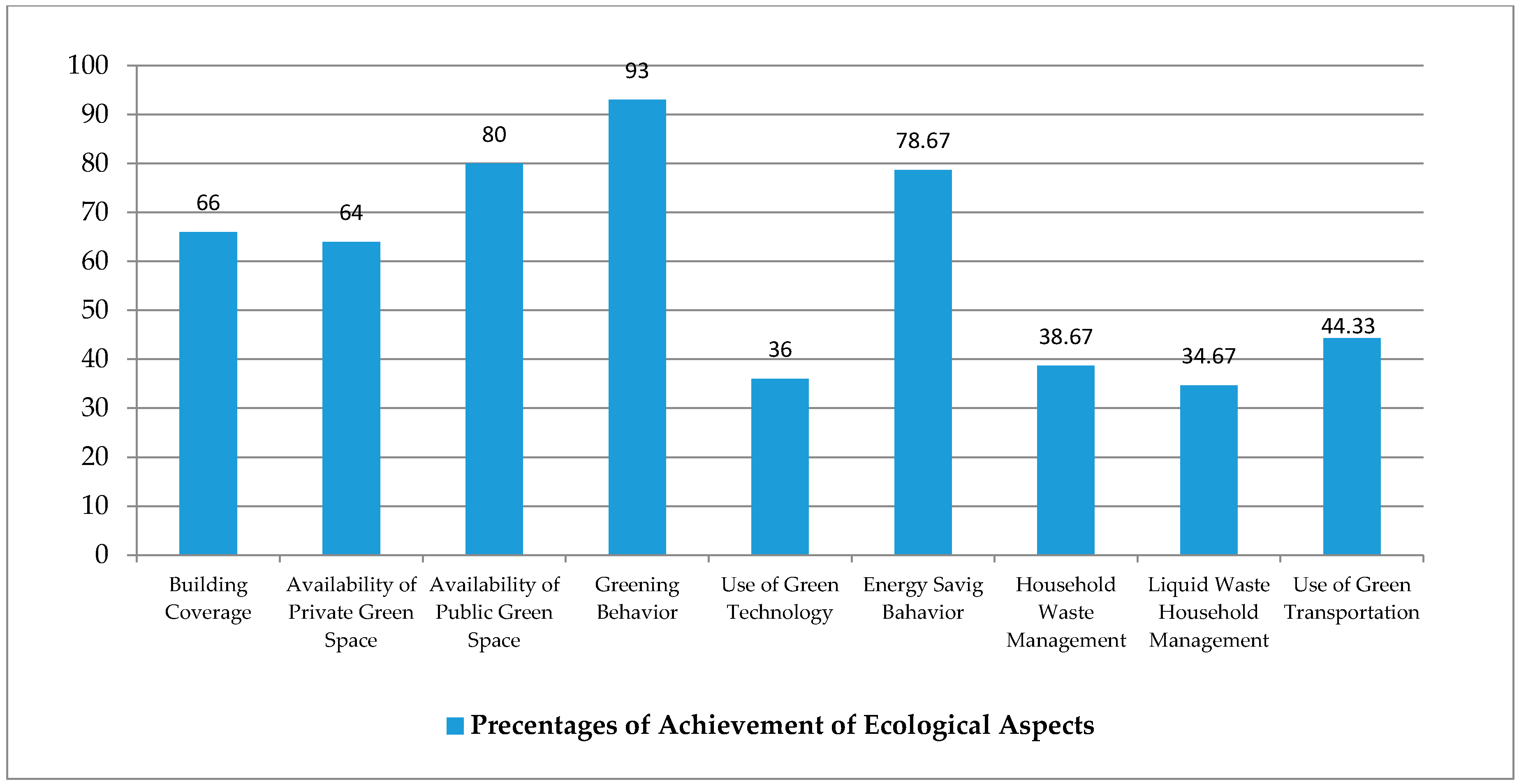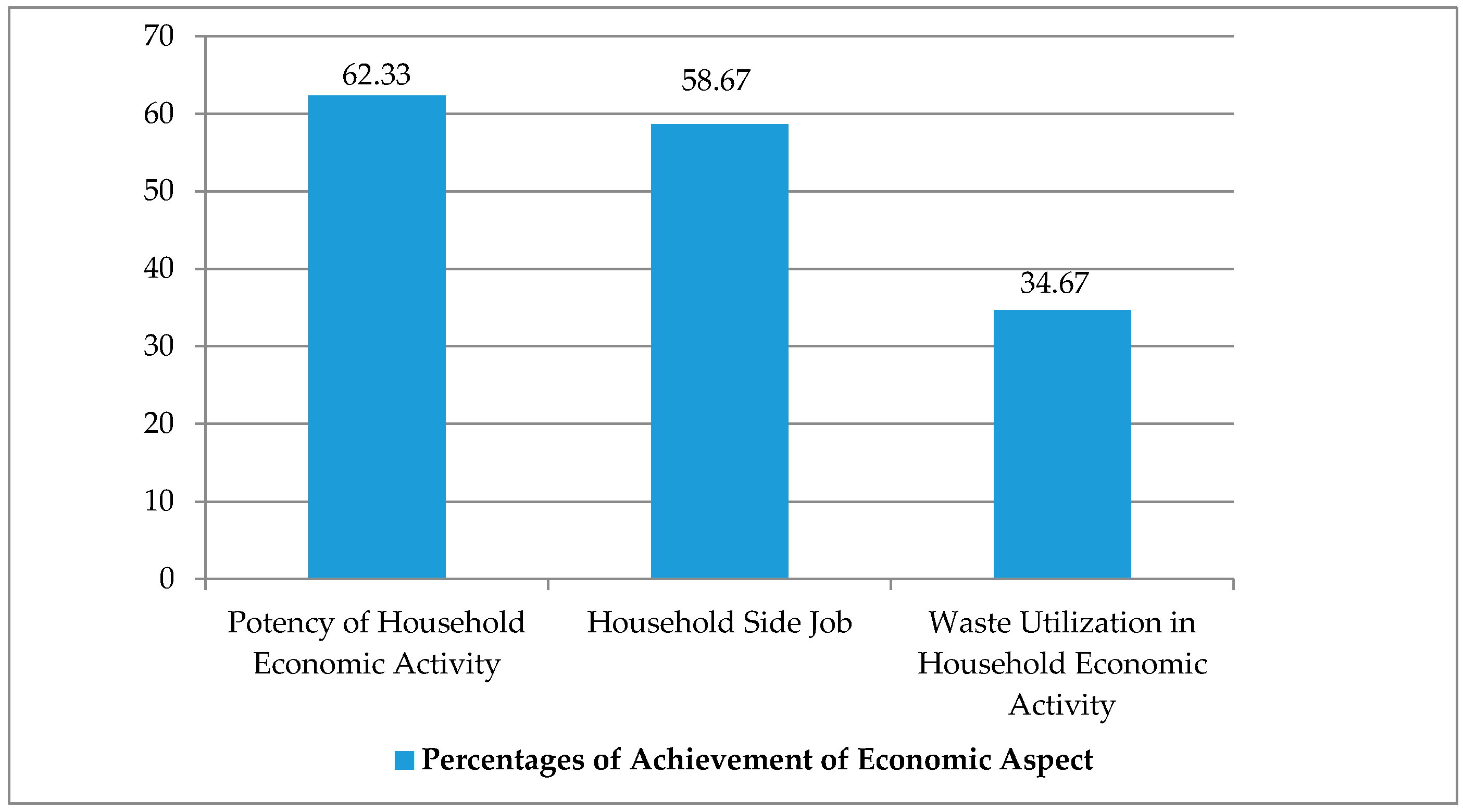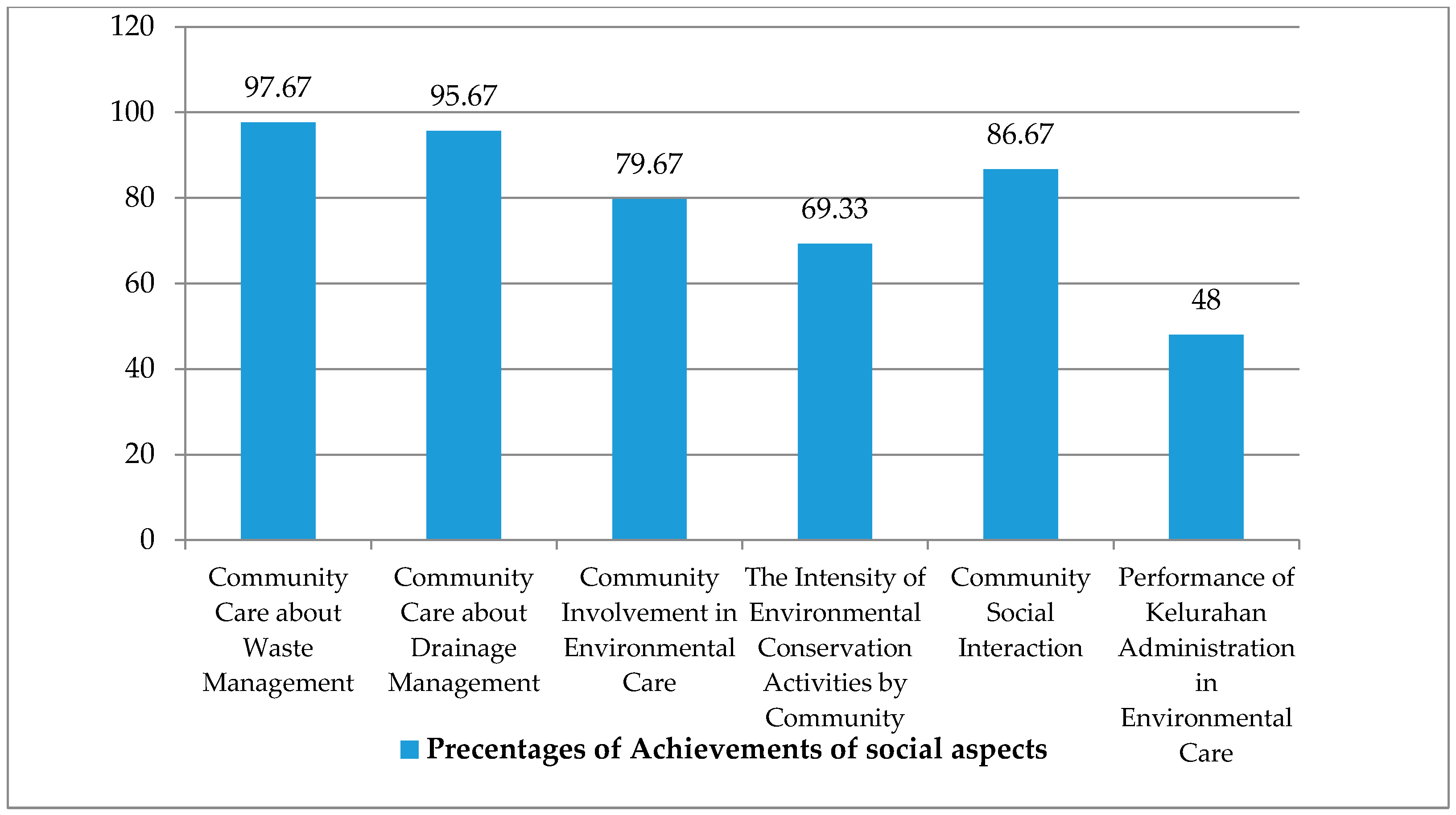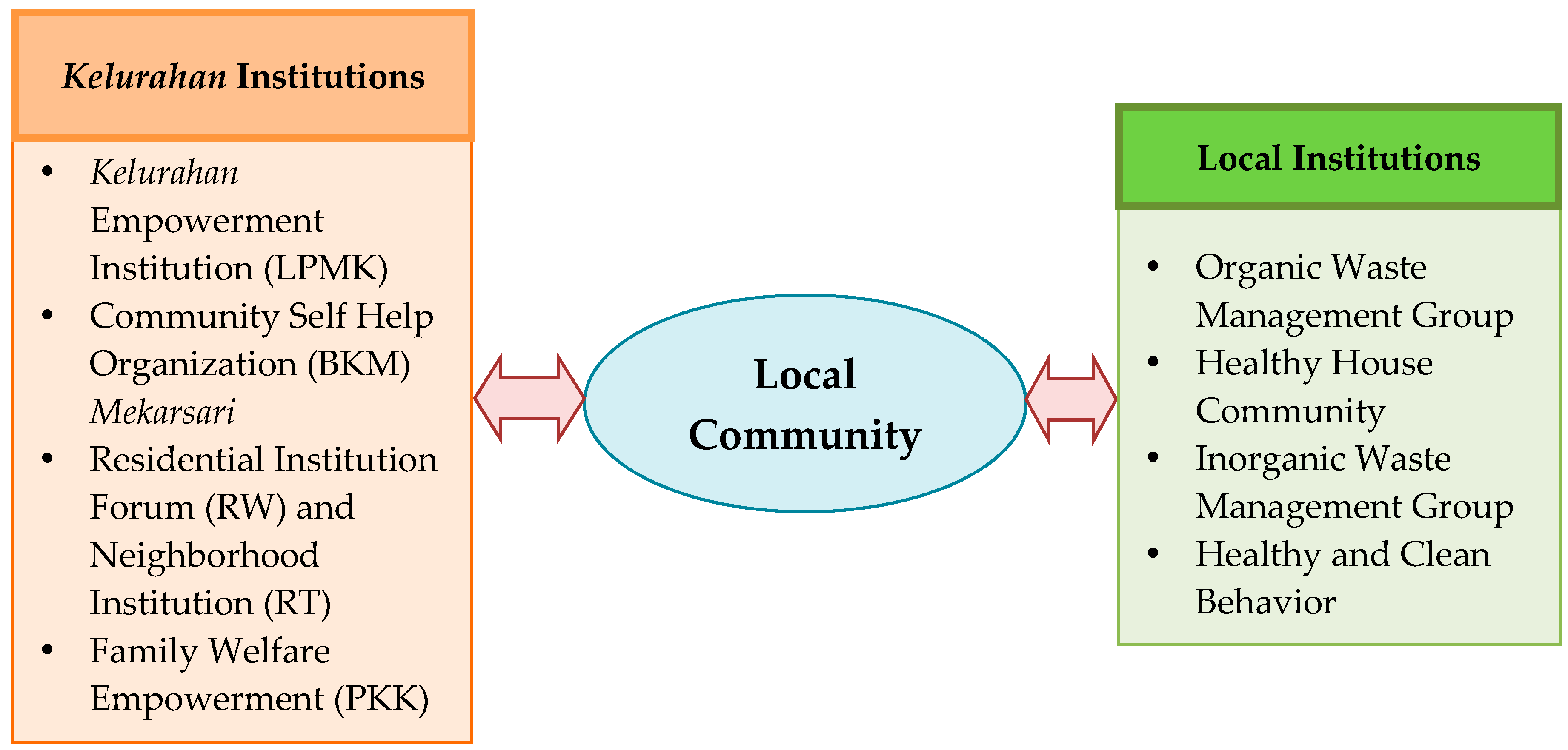1. Introduction
The implementation of eco-settlement initiatives is among the efforts to ensure sustainable urban development. This initiative requires synchronization between a city’s government and its community. Strategic measures are being taken in order to address problems due to the increasing number of settlements in metropolitan areas. Measures will also need to be aligned with the ecological approach to achieve the ideal of sustainable development. There are two key principles in the eco-settlement initiatives: a healthy ecosystem that can support social-economic activities, and a well-built environment.
An eco-settlement initiative that addresses environmental issues and is highly relevant to the geographic condition of Indonesia is the eco-village approach. This approach is suitable for a tropical country. It introduces harmony between social, economic and ecological elements to achieve a sustainable means of tropical living. The eco-village concept ensures ecosystem sustainability through considerations in design and planning, such as maintaining green space to maximize ecological function. This concept can also help design and plan urban green infrastructures, urban ecology in green lifestyles and systems integration. The term “green” is used to show more care and attention to environmental issues, including environmental thresholds and limits, as well as climate change [
1]. Therefore, an eco-village is defined as a full-featured settlement that implements human activities integrated with nature in ways that improve healthy human development [
2]. The concept of an eco-village, however, cannot be successfully implemented without support from four different aspects, i.e., ecological, economic, social and institutional aspects, respectively [
3].
In Semarang City, economic production levels reflected by the Gross Regional Domestic Product (GRDP) are on the rise. The GRDP of Semarang City increased from 9.58% in 2012 to 11.47% in 2014. Unfortunately, an increasing GRDP is not necessarily followed by environmental awareness. Indeed, environmental degradation is often concurrent with economic improvement due to the increasing of population and human activities. However, Kelurahan Gayamsari is no exception.
Gayamsari is one of 177
kelurahans (village-level administrative unit in Indonesia) in Semarang that has taken the initiative to go green, meaning that the
kelurahan administration and the people have engaged in efforts to protect the environment. Subsequently, the
kelurahan and its community have decided to adopt an eco-village approach initiated by the local government of Semarang. Gayamsari has a program to actualize an environmentally friendly neighborhood. The program, launched in 2010, is based on 1997’s Act No. 23 on Environmental Management [
4], Government Regulation No. 41 of 1999 on Air Pollution Control [
5], Semarang Mayoral Letter on the Implementation of Environmental Village Competition in 2011 [
6], and the Decree of the Head of
Kelurahan in 2010 about Environmental Quality Improvement [
7]. The purpose of the program is to increase participation and to empower citizens in the neighborhood institution, or
Rukun Tetangga (RT), and in the residential institution, or
Rukun Warga (RW), to develop and maintain the environment in order to create a clean, green, and environmentally friendly neighborhood.
Although Gayamsari has been labeled environmentally friendly, environmental problems remain. One of the causes is that Gayamsari is densely populated, with 97.2% of its area built-up. The residential area has taken over the green space, consequently reducing the water absorption area. Moreover, the inadequacy of the drainage system leads to frequent flooding in the rainy season. This inevitable flooding occurs because of a large amount of rainwater discharged from Kanguru Road and the Gayamsari Highway. The underground drainage channel is not able to accommodate the overrun water. Further drainage problems exist, i.e., additional waste water flow as well as the number of street vendors occupying the buffer zone of the main drainage channel of Gajah Raya Street. This illegal occupation creates difficulty in normalizing the channel and performing a general clean-up. As for the community, many people may not be aware of the environmental management system and thus do not encourage it. Therefore, it is necessary to uncover the level of eco-village achievement engendered by the participation of the local community and Gayamsari institutions.
2. Eco-Village and Settlements
Among the first to introduce the concept of an eco-village was the World Commission on Environment and Development (WCED) at the 1992 Earth Summit in Rio de Janeiro, Brazil. The committee reported on the environmental issues emerging at that time, such as global warming, water shortages, biodiversity loss and increasing global poverty [
8]. The eco-village concept is guided by the Global Eco-village Network (GEN) [
9]. GEN is a global association of individuals and communities dedicated to sustainable living towards land restoration as well as the application of the concept “adding more to the environment is always better than taking” [
10]. The vision of GEN is that all life beings are united harmoniously on earth, a planet that can fulfill the needs of present and future generations [
9]. Furthermore, it needs can continue being met by identifying, assisting, and coordinating the efforts of the community to create harmonization of social, spiritual, economic and ecological aspects. According to Capra [
11], an eco-village is a human community in urban or rural areas. An eco-village emphasizes the integration of a social environment that supports living with a low impact on the natural environment, entailing lower and more efficient energy use [
12]. Thus, an eco-village integrates various aspects such as ecological design, permaculture, ecological building, green production, alternative energy, and building local communities. An eco-village is expected to solve many problems on earth and it is an example of how to prevent and reverse the degradation of the environment with social, economic, ecological, and spiritual measures to move a community towards sustainability in the 21st century.
Eco-villages encourage community members to pay more attention to the environmental, social, and physical conditions around them [
13], thereby enforcing public participation in environmental quality improvement. The Korean islands serve as an example, where local knowledge is shown to benefit environmental improvement [
12]. Moreover, public participation and incentives encourage the local community’s engagement in the environmental management program, such as the recycling program of a community’s solid waste [
14].
Eco-villages should develop through the sharing process involving the elements of interaction and togetherness to achieve the environmental, economic, social, and organizational sustainability [
15,
16]. There is a common goal to be achieved in the eco-village: the communities must be connected to their environment [
17]. Also, there is a correlation between social interaction and quality of the environment [
18]. However, the communities also need the support of local institutions to drive their participation in improving environmental quality [
19]. Stronger collaboration between the individual and organizational levels—such as the community, local institutions, public agencies, non-profit organizations, and other stakeholders—is needed to achieve a more sustainable social‑ecological system [
20].
Among the first eco-villages is the Grand Shandu Eco-Village System (GSES) in Jiande City of Zhejiang Province, China. An evaluation four years after its implementation in 1988 showed remarkable success with all three (economic, environmental, social) pillars of sustainable community life showing significant progress [
21]: poverty incidence was reduced; environmental quality was improved; and harmonious social life was enhanced. GSES was considered successful in ensuring village-level sustainability in Jiande. According to Hu and Wang [
21], four factors are mainly responsible for this success, i.e., first, green construction that prioritizes the use of local materials; second, ecological planning of the village; third, good social institutions in managing human‑environment relations; and fourth, empowerment of local culture in the aspects of behavior, psychology, intelligence and consciousness.
One of the newest eco-villages is in Iran [
22]. This case is interesting in the sense that this local, decentralized eco-village initiative can be analyzed within the centralized political context of Iran. Although the Iranian approach to developing an eco-village may be locally specific as the relationship between democratization and environmental activism is different than that of democratic countries, the importance of participation of the people and local institutions is the same. In an indispensable work by Ergas [
16], she highlights the aspect of collective identity in the case of an eco-village in the Pacific Northwest United States. Collective identity of the eco-villagers can be considered key to the successful movement towards sustainable living in the context of the larger political structure that may be obstructing it.
Inter-organizational networking is another important aspect in developing an eco-village, and it is closely related to local institutions, as evidenced in the case of Cleveland’s eco-village [
23]. Networking’s role has proven to be so essential that it, in turn, influences other nearby housing developments in Cleveland to be more environmentally friendly. Institutional networking at the local level should thus be considered when assessing any eco-village development.
The successful case of Dancing Rabbit Eco-Village in Missouri, USA, moreover, suggests that the most important factor in the remarkable savings of the village’s energy and resources is collective resource management [
24]. This kind of management moves away from exclusive private and individual ownership of natural resources. Local people’s participation is essential in ensuring successful collective management of resources, and this is in agreement with the many eco-village studies discussed previously, including the third and fourth factors of the successful GSES.
Another paper that emphasizes the importance of people’s participation in developing an eco‑village is by Ngah and Zulkifli [
25]. Studying the case of Felda Taib Andak in Iskandar Malaysia, they found that the tacit knowledge of the local communities was a crucial contribution to the eco‑village’s planning and implementation. Felda Taib has become a prospective eco-village and low‑carbon emission area, applying an innovative approach that is not command and control (CAC), nor uses market-based instruments (MBIs). While this approach looks like CAC, it applies the polluters pay principle, thereby including some charge incurred for violation of command. Perhaps this kind of approach is more appropriate for developing countries as is also shown in [
26].
Another aspect is particularly worth noting in this context [
27]. Relocalization and spatial decentralization, as encouraged by the eco-village concept, are often considered automatically able to lead to long-term sustainability. However, there are problems at the urban and metropolitan levels also in need of a variety of improvement strategies, among which are those developed in the model of sustainable metropolitan development for Semarang [
28]. It is not surprising then that Xue proposed and demonstrated that multi-scalar strategies considering the multifaceted relation between typical social transformation and spatial development are needed to ensure sustainable urban development.
By and large, the principles of the eco-village are applicable to urban and rural areas, both for developing and developed countries. Eco-villages can also provide solutions to human needs, environmental protection and substantial improvements for all life. Thus, it is necessary to fulfill the missions of the eco-village when implementing the concept.
3. Methods
This study first aims to measure the level of eco-village implementation in Gayamsari by delineating and exploring variables, key indicators, and measurements. Descriptive analysis was used to statistically analyze the data by describing data collected through questionnaires and observation. The instruments used are proportional random sampling with questionnaire distribution to 100 households of Gayamsari inhabitants. Thus, the respondent units are households. There is a total in Gayamsari of 3290 households, which are located in nine RWs. The RW boundaries in Gayamsari can be seen in
Figure 1. The sample size for each RW is 10 to 15 households.
The descriptive quantitative method is used with scoring analysis tools. Analysis of scoring was used to assess certain criteria or assessments using a measurable scale. Assessment aspects of eco‑village achievement by community participation were analyzed using quantitative descriptive presentation through tables, graphs, diagrams and calculation of data dissemination through the calculation of average and standard deviation.
The aspects that represent eco-village achievement are ecological, social, and economic aspects. The scoring analysis is to measure the indicators of eco-village achievement. The scoring technique aims to assess the indicators that have been implemented using community participation in Gayamsari. The indicators are used as the benchmark in drawing up the questionnaire with the criteria as shown in
Table 1. The better the condition according to the criteria, the higher the score will be.
A Likert scale is used in this scoring method to classify the level of each indicator. Each indicator is allocated to one of three classes, i.e., low, moderate, and high levels, with the score ranging from 1 to 3, respectively. Subsequently, the indicators are added to get the total score that indicates the level of eco-village aspects achievement. The total score is then interpreted into the classification of eco‑village aspects implementation as seen in
Table 2.
4. Towards Kelurahan Gayamsari as an Eco-Village
According to the Spatial Planning of Semarang City 2011–2031, the main land uses in Gayamsari are for residential areas with moderate to high density, in addition to trade, service, and transportation centers [
30]. Gayamsari is strategically located at the heart of the city and supported by these abundant trade and transportation centers. It is surrounded by major highways (Brigjend Sudiarto Street and Gayamsari Toll Road) only 3 km from downtown Semarang City. With regards to local governance, Gayamsari is a village (
kelurahan) led by a head of village (
Lurah), which consists of several RWs, while each RW comprises several RTs.
The RTs and RWs function as neighborhood administrative areas. The RT is a residential forum of households in a neighborhood community, usually comprising 20 to 50 households. The RT’s tasks include administrative work, coordinating community safety patrols and organizing social activities. Meanwhile, the RW usually comprises three to seven RTs and coordinates social activities involving its member RTs. Gayamsari is divided into 9 RWs and 67 RTs. The Building Coverage Coefficient is around 80% on average, and the number of families is 3290 households. Gayamsari’s population is 13,216 people, made up of 6710 men and 6506 women. The population density is high, i.e., 156 persons per hectare, due mostly to the presence of domestic immigrants.
Gayamsari eco-village is a program initiated by the Kelurahan Gayamsari government to actualize an environmentally friendly neighborhood. The program was launched in 2010 with the full support of the kelurahan organization and the surrounding communities. This program is implemented by the community in each RW through greening activities, management of household waste, and application of environmentally friendly technologies supported by good community participation. The strong role of community participation is evidenced by the presence of green communities such as Community Care for the Environment groups, or Kelompok Masyarakat Peduli Lingkungan (KMPL), and waste management groups.
4.1. The Ecological Aspect
Gayamsari has an area of 90 hectares, 84.6 hectares (94%) of which is residential, whereas the remaining 5.4% is used for public facilities. The proportion of the built-up area in Gayamsari is 97.2%. A total of 89.07 hectares of the land use in Gayamsari is used for the built-up area, including the settlement, the trade and service areas, among others. This condition causes a lack of green space to maintain ecological functions. In turn, the microclimate becomes hotter and more humid.
The high level of Building Coverage Ratio (BCR) is due to the limited availability of land, uncontrolled land use as well as lack of knowledge and awareness of BCR regulations. In fact, there are only a few respondents who keep their backyards green by not converting them into a hard surface or engaging in additional built-up uses. The percentages of BCR in Gayamsari are shown in
Figure 2.
As for the Green Coverage Coefficient, or
Koefisien Dasar Hijau (KDH), as much as 36% of respondents have 10% to 19% KDH. Most of the private residential green space is well maintained and can function as a water catchment area. The highest KDH level is in RWs 5 and 6, indicating that respondents in the area utilize the space efficiently while maintaining their private green space. The presence of residual land or yard can be utilized as a park or any other greening initiatives. The existence of green space as a water absorption area will improve the ecological function of the larger area. The availability of green space is usually in the form of community parks such as RT gardens, RW gardens or neighborhood parks. Currently, the neighborhood parks can only be found in some RWs such as in RWs 3, 4 and 5 (
Figure 3). This information suggests that there is not enough green space to meet the ecological needs, potentially creating environmental imbalance and resulting in further environmental damage. Several approaches can be taken (
Table 3), such as increasing the number of community parks, improving the quality of green space along the main street corridor, raising community awareness as well as educating and encouraging the green movement as coordinated by the local groups of the KMPL and the RTs in
Kelurahan Gayamsari.
In addition to the KMPL, there are two other community groups, i.e., the Group of Clean and Healthy Home and Behavior, or
Perilaku Hidup Bersih dan Sehat (PHBS), and the Inorganic and Organic Waste Processing Group. These three groups are included in the RW organizational structure and initiated by the women who fused in Family Welfare Empowerment or
Pembinaan Kesejahteraan Keluarga (PKK). Inorganic and organic waste processing groups have applied the eco-village concept through initiating the composting program and helping with recycling inorganic wastes including plastic bags, plastic bottles, scrap paper, and snack wrappers and turning them into useful products such as crafts (
Figure 4). Although this helps to reduce household waste, the role of these groups is more intense in RW 4 than in the other RWs. It is thus also indicated that RW 4 has a higher level of community participation with regard to the care and maintenance of the environment, and it appears that these RW4 groups have more concern for the environment than those of the other RWs. The community-based waste management is beneficial to reducing the household waste and will improve the local economy through community collaboration [
31].
The level of eco-village achievement in Gayamsari based on the ecological aspect is medium with a 59.48% achievement score (
Table 4). From all the indicators of the ecological aspect, the highest achievement score is obtained by the greening behavior of the community in Gayamsari with a score of 93%, while the lowest index is liquid waste household management with a score of 34.67% (
Figure 5).
The ecological achievement based on the greening behavior has a high value because the Gayamsari communities have a high level of concern and many initiatives in greening activities in their neighborhood. Many plants have been grown to maximize the function of green space that make the achievement level of public and private green space high enough.
However, the achievement levels of household waste management, liquid waste household management, green technology, and green transportation are low because the communities are less concerned in these programs. Moreover, all these activities are difficult to perform as part of one’s daily activities due to limited funds, manpower, and time.
It is important to note that not all of the indicators are applied by the Gayamsari communities. Green indicators are not only about greening activities, but also about other factors such as residential waste management, the use of environmentally friendly technologies and transportation as well as an energy-saving mindset. The results of the implementation could be maximized if the municipal government is able to encourage and motivate community behavior to become more aware of the environmental sustainability principles and apply them in day-to-day life. There are also some indications that part of the program has not successfully been implemented and needs improvement to achieve the objectives.
4.2. Economic Activity
Economic growth is one of the indicators of the people’s welfare. If the economy improves, which has already been shown in Gayamsari in terms of growing local businesses such as home industries, more effort towards sustainability is needed. In fact, creating an eco-village requires a lot of support from the local economy and businesses to help boost the income level of the residents. Moreover, some activities by the community have the potential to improve the economy, such as local waste management that can also have economic added value.
Also, there are four types of home-based enterprises (HBE) that have been quite productive in Gayamsari, i.e., wedding planning, calligraphy art, cake mold making, and soybean curd or meatball home industries. Calligraphy or Islamic art and the cake mold businesses have provided jobs for local laborers, thus illustrating that HBEs can help local communities improve their income level. Moreover, the rising number of local and HBE businesses helps to motivate further community members to open their own businesses with the transferable skills they have gained from working for others. This occurred, for instance, with the initiation of the calligraphy painting business. Productivity of HBEs has been proven effective in trickling down to the community members and surrounding communities. These businesses have the potential to grow even larger, thereby providing more jobs which is not only good for economic growth but also for equity. In Gayamsari, there are four clusters or types of business groups as seen in
Table 5.
The level of the eco-village’s economic achievement in Gayamsari is low, with a 51.89% achievement score (
Table 4). Of all the economic indicators, the highest achievement score is obtained by the potential of household economic activity in Gayamsari with a score of 62.33%, whereas the lowest score is waste utilization in household economic activity with a score of 34.67% (
Figure 6).
Economic achievement based on household economic activity has high value because of the strong potential of the Gayamsari communities to run businesses independently. The employees are mostly housewives who have gained transferable skills from business owners that they can hopefully use one day to start their own businesses. However, such activities are only apparent in RWs 3, 4, and 8. The other RWs have not yet implemented household-based economic activities due to less community involvement, as well as limited capital, manpower, and time.
In community-based economic development, community efforts to develop side businesses or other local economic activities helps increase family incomes. It is a good sign of a growing economy led by the locals and it has been proven to be more resilient to global economic downturn. Efforts of the local community of Gayamsari could be improved by building, transferring and diversifying additional skills and opportunities. The types of businesses already established have also opened up another opportunity—the waste recycling business. However, only 4% of the population knows how to reuse and recycle household waste. An example is the recycling of banana leaves to be used for manufacturing wall paintings. Currently, only a small portion of the community in Gayamsari repurposes household waste into useful materials for potential businesses, thereby indicating that local community members need to work together more efficiently, sharing skills and knowledge to better develop and explore environmentally friendly businesses.
4.3. Community Participation and Involvement of Local Institutions
The crucial social dimension of a developing eco-village can be seen in the interactions, commitments, and community involvement; the eco-village settlement would have no meaning without community participation. Another important element of achieving sustainability is the people’s commitment to changing their behavior towards being more caring for the environment. At its core, an eco-village is community life wherein people feel supported by, and accountable to, the other people around them. Therefore, community commitment and involvement are needed in the implementation of the eco-village, especially in the form of spreading awareness about environmentally friendly behavior. The role of community groups and the local government institutions has to align with environmentally friendly principles.
Table 6 presents the types of local institutions in Gayamsari along with their respective roles and shows that the KMPL focuses more on environmental activities.
As seen in
Table 6 above, there are many different types of local institutions that have the potential to educate on environmental awareness through social and other activities. Overall, social activities are carried out routinely at every level of the community since the community members usually have regular meetings at least once a month. Gayamsari community participation is extremely good, especially in the activities to enhance the quality of the environment, such as planting vegetation beneficial for their health. This is promoted by the city’s government through a program known as Medicinal Plants for Family, or
Tanaman Obat Keluarga (TOGA). This type of activity is led by the KMPL and PKK at the
kelurahan, RT and RW levels (
Figure 7).
The existence of several non-governmental organizations also becomes part of the implementation of the eco-village for the local community. The NGOs are in charge of implementation of all forms of environmental programs and activities.
Table 7 shows the breakdown of KMPL activities to improve the quality of the environment in the Gayamsari eco-village.
KMPLs were formed by the community with the support of the kelurahan administration. They therefore work efficiently and focus on program implementation. The KMPLs aim to improve community participation, especially in terms of housing quality. Their mission is to create a safe and healthy residential environment to meet basic human needs. Their goal is to maintain a clean and healthy environment carried out by the cadres and local community members, emphasizing proactive and productive awareness and activities.
The level of eco-village achievement in Gayamsari based on the social aspect is high, with a 79.50% achievement score (
Table 4). From all indicators of the ecological aspect, the highest achievement score is obtained by community care about waste management, with a score of 97.67%, while the lowest index is by the performance of
kelurahan administration in environmental care, with a score of 48% (
Figure 8).
Social achievement based on community care about waste and drainage management has a high value because Gayamsari communities have deep concern for environmental cleanup activities in their neighborhood. Because they care for their neighborhood, as evidenced through the KMPL, there is high community involvement in environmental conservation. However, the performance of the kelurahan administration in environmental care is low because of the limited funds, manpower, and time that prevent the administration from maintaining green action. Analysis of community activities clearly shows that Gayamsari communities have robust and diverse interactions. The proactive and intensive community participation supported by the local institutions is thus proven to support the social aspects of the eco-village.
4.4. Dimensions of the Eco-Village
The eco-village settlement is a condition in which the community members play a significant role in improving the environmental quality in their neighborhood. The eco-village program is an effort to turn Gayamsari into a green village in the fast-growing urban area of Semarang. In order to undertake an overall performance assessment of the Gayamsari eco-village, it is necessary to analyze a variety of indicators as well as environmental, social and economic dimensions (
Table 4).
Table 4 shows that Gayamsari has an average score of 194.67 with an overall achievement of 64.40% in implementing the eco-village. This score means that the achievement of Gayamsari in developing an eco-village settlement is at a lower-medium level. However, achievement in the social aspect is the best among the three dimensions, i.e., 79.50%, which could aid in the future development of Gayamsari eco-village. Achievement in the ecological aspect is far from good at only 59.48%. However, because Gayamsari communities are fairly open and have started developing more community initiatives, such as business clusters, improvement is foreseeable. Similarly, the economic dimension has a poor performance at 51.89%, requiring enhancement through environmentally friendly strategies to improve the local economy.
Community participation, particularly in environmental preservation activities, already averages well as the people are regularly involved in such activities. This high level is also supported by the public awareness factor since the communities understand the importance of maintaining a good environment to improve quality of life. The proximity and involvement of the kelurahan administration and the local community also encourages commitment, though additional innovative partnerships between the local government with other institutions for providing information and assistance to the community about every aspect that could help the eco-village would be more ideal. Luckily, the local government is expected to cooperate with other agencies to improve environmental quality by procuring, for instance, assistance agreements and greening initiatives with the Department of Agriculture and Forestry, and subsidized composter units as part of Corporate Social Responsibility (CSR) of relevant companies. Also, composting training and equipment procurement for biopores by the Environmental Board of Semarang City can be made available for Gayamsari. The biopore manufacturing program is being widely initiated in Semarang due to its great ecological and environmental impacts, such as water absorption and conversion of organic waste into compost.
Gayamsari can maximize its efforts of improving the environment through partnerships between
kelurahan administration, local agencies, and the people. The
kelurahan administration, for example, has entered into collaboration with formal and non-formal institutions to socialize, organize, implement, and invite the public to participate in the implementation and monitoring of the eco-village (
Figure 9).
The partnership chart above shows that the kelurahan administration collaborates with the LPMK to accommodate the aspirations of the community and deliver the programs and activities of a green village. The Community Self-Help Organization (BKM) serves as an institution that receives external assistance about infrastructure and distributes it to the public. The RT recounts the residents’ aspirations to the kelurahan administration, whereas the KMPL functions as a messenger to manage and improve the environmental quality in the lower level of institutions such as RWs and RTs. The PKK at the kelurahan level works together with the kelurahan administration to convey all information, conduct community outreach, and promote environmentally friendly behavior. Lastly, the Organic Waste Management Group, the Healthy House Community, Clean and Healthy Behavior in collaboration with the RT urge the community to take actions, starting in the home, to save the environment by being aware of environmental issues and conducting action plans to reduce the impacts of climate change and global warming.
The current collaborations have been working properly; however, they are prone to discontinuity due to limited manpower and time. For instance, the cooperation between the KMPL and the kelurahan administration has been reduced due to the decreasing members and administrators of the KMPL. The KMPLs have not fulfilled their expected role in the environmental monitoring program. In addition, due to limitations of the kelurahan administration, the eco-village program is poorly controlled and monitored. Consequently, the independent waste processing and biopore manufacturing have become less sustainable. During the post-program, the kelurahan administration has not performed the monitoring and evaluation phases. In general, Gayamsari has been able to retain the initiatives especially in the implementation of environmental friendliness through various environment-related activities. Overall, it can be said that all the stakeholders have worked together and performed their duties in the attempt to create an eco-village at Kelurahan Gayamsari.
The importance of an eco-village in ensuring a sustainable community has been proven in
Kelurahan Gayamsari. Rosenthal [
32] stated that a combination of two truths—value and support for a healthy community, and the restoration and improvement of traditional community life—could be the way toward sustainable humanity. In this vein, the synergy within Gayamsari has supported the realization of the eco-village and sustainable urban development in general because it developed as a response to the social and environmental problems of our time [
33].
5. Conclusions
Kelurahan Gayamsari has tremendous potential to become an eco-village through the various community efforts that have been undertaken. The implementation of the eco-village concept can contribute significantly to ensuring sustainable urban development when there is harmony between the three dimensions, i.e., social, economic, and ecological aspects. Although many criteria have been fulfilled in Gayamsari’s eco-village implementation, certain criteria such as a healthy environment, public participation in environmental awareness, as well as institutional work still need to be improved.
The community’s involvement in maintaining a clean and healthy settlement is largely determined by its human resources, including sense of community, sense of belonging and social gratification towards the surrounding environment. The sense of community is evident in the forums of the PKK’s gatherings to discuss programs related to the eco-village development. The sense of belonging is apparent in kerja bakti, a kind of voluntary work by the community to maintain a good living environment. Furthermore, social satisfaction is seen in the emergence and development of local community institutions, such as the KMPLs, contributing significantly to the improvement of the Gayamsari eco-village. Also, social interaction as collective behavior determines the level of achievement of eco-village settlement. The role of the KMPL, which can be considered as a manifestation of community participation, continually needs to be strengthened.
Apart from some improvements that are still needed, the Gayamsari people’s efforts to implement an eco-village by striving for lifestyles that can be sustained, can be seen as a living model of sustainability, thus illustrating how community actions and local organizations can make significant contributions. They represent an effective and practical way to resolve the degradation of the social and ecological environment.
This study has highlighted the instances in which Gayamsari can provide valuable lessons to sustainable settlement initiatives in dense urban areas. As the search for sustainable solutions to settlement problems continues, the eco-village is in a strong position to become increasingly relevant in the future. The implementation of the eco-village program in Gayamsari would not be successful without the participation of the community and the assistance from local institutions and community groups. Achieving the objectives of an eco-village also needs the local government’s and
kelurahan’s participation. Gayamsari’s institutions thus need to become more involved in helping to control and manage the problems that may arise along the way. The community should be invited to participate and be actively involved in the environmental management. To properly build an eco-village, community participation is strongly required at all stages, from planning and implementation to monitoring and evaluation. This remark is in agreement with, for example, the findings of Sugiri [
34] and of Sugiri, Buchori, and Ma’rif [
35]. The motivation for an eco-village is the need to reverse the gradual disintegration of supportive social and cultural structures and the upsurge of destructive environmental practices on our planet [
9].
